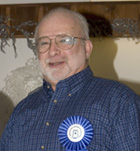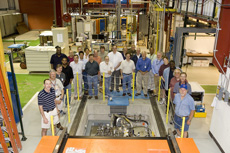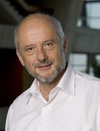|
Tue., Aug. 14
3:30 p.m.
DIRECTOR'S COFFEE BREAK - 2nd Flr X-Over
THERE WILL BE NO ACCELERATOR PHYSICS AND TECHNOLOGY
SEMINAR TODAY
Wed., Aug. 15
THERE WILL BE NO FERMILAB ILC R&D MEETING THIS WEEK
3:30 p.m.
DIRECTOR'S COFFEE BREAK - 2nd Flr X-Over
THERE WILL BE NO FERMILAB COLLOQUIUM THIS WEEK
Click here for NALCAL,
a weekly calendar with links to additional information. |
Tuesday, Aug. 14
- Tomato Bisque
- Lemon Pepper Club
- Burgundy Beef Tips
- Smart Cuisine: Tortellini Alfredo
- Grilled Chicken Caesar Wrap
- Assorted Slice Pizza
- Rio Grande Taco Salads
*Carb Restricted Alternative
Wilson Hall Cafe Menu |
|
Wednesday, August 15
Lunch
- Chinese Chicken
- Mushroom Lettuce Cups
- Grilled Bananas w/Rum Sauce
Thursday, August 16
Dinner
- Smoked Salmon Napoleon
- Tournedos of Beef w/Madeira Sauce
- Cauliflower Gratin
- Vegetable of the Season
- Bourbon Walnut Pie
Chez Leon Menu
Call x4598 to make your reservation. |
|
|
Steering Group draft report discussions scheduled
All Fermilab employees and users are invited to attend the upcoming
presentations and discussions of
the Fermilab Steering Group draft report. The first meeting will be on
Friday, August 24 at noon in Ramsey Auditorium. To give users more time to
make travel arrangements, a Town Hall meeting organized by the Users
Executive Committee has been scheduled for Thursday, September 27 at 5 p.m.
in One West. Fermilab Deputy Director Young-Kee Kim will lead the program at
both meetings.
|
John Kedzierski,
T&M manager
 |
| John Kedzierski |
Fermilab employee John C. Kedzierski, manager of the Time & Materials office in the Facilities Engineering Services Section, died on Saturday, August 11, at home. He was 58. He had been on leave from Fermilab since January 29, undergoing cancer treatment and a bone marrow transplant.
Kedzierski, a Vietnam War veteran, joined Fermilab as a maintenance electrician in July of 1975. In 1989, he began to work for the T&M office, coordinating the laboratory's needs for contractor services. In 1994, he became the manager of the T&M office.
"John would strive to keep a core group of trained and skilled contractors available for work at the lab," said Kent Collins, his supervisor. "He was one of the people that you never had to follow up on. In his job, he was always balancing priorities, and he managed to be fair to everybody. There was never a problem."
Kedzierski is survived by his wife of 35 years, Carolyn; two sons; and four grandchildren.
"John was an optimist but also a realist, including during the time of his sickness," said Randy Ortgiesen, head of FESS. "He knew the risk of his medical procedures. This is really sad."
Visitation will be today, August 14, from 4-8 p.m. at the Beverage Family Funeral Home, Sandwich Chapel. Funeral services will be Wednesday, August 15, at 10:30 a.m. at the First Lutheran Church in Plano. In lieu of flowers, the family wishes donations to be made in John's name to the Sandwich Lions Club or the First Lutheran Church of Plano.
|
Fermilab's Vertical Test Stand paves way for ILC

The completed vertical test stand at IB1 and the VTS project contributors who were available for this photo opportunity.
While the International Linear Collider is still in the planning stage, Fermilab is taking part in cutting-edge research that will be crucial to turn the ILC into a reality. In late July, scientists from the Fermilab Vertical Test Stand team in collaboration with DESY, Jefferson Laboratory and Cornell successfully tested their first single-cell superconducting cavity, proving the reliability of their system and opening the door for future ILC development at Fermilab.
The main components of the ILC's design are the superconducting cavities --16,000 of them to be precise. Made of the superconductor niobium, these hollow structures accelerate electrons and positrons to nearly the speed of light. However, before the cavities can be assembled, they must be tested -- one at a time.
The VTS accomplishes just this task, and the recent test was the first for the new system. The single-cell test cavity, which was provided by JLab, reached a gradient of 27 MV/m (megavolts per meter) at a temperature of 2 deg Kelvin during the test. ILC cavities must achieve an average gradient of 31.5 MV/m.
Joe Ozelis, the resident cavity-test system expert, was pleased with the results, but emphasized the need for more testing. "These first results are encouraging, as no significant issues with hardware, interlocks or software were found," Ozelis said. "However, we still intend to optimize the radiofrequency and data acquisition systems, and we will, of course, take steps to minimize measurement errors."
The VTS now enters a "commissioning period," designed to allow for precisely these types of calibrations. The team plans to test a nine-cell ILC cavity this month, and if all goes well, the system should enter "production mode" -- full-time ILC cavity testing -- soon afterward.
Ozelis congratulated the team for its successful startup of the VTS. "This achievement was made possible by the hard work, tireless dedication and concerted efforts of many people," he said.
-- J. Bryan Lowder
|
From Forbes,
August 12, 2007
Race Is on to Detect Dark Matter
LOS ANGELES -In deep underground laboratories around the globe, a high-tech race is on to spot dark matter, the invisible cosmic glue that's believed to keep galaxies from spinning apart.
Whoever discovers the nature of dark matter would solve one of modern science's greatest mysteries and be a shoo-in for the Nobel Prize. Yet it's more than just a brainy exercise. Deciphering dark matter - along with a better understanding of another mysterious force called dark energy - could help reveal the fate of the universe.
Previous hunts for the hypothetical matter have turned up nothing, but that has not deterred some two dozen research teams from plumbing the darkness of idled mines and tunnel shafts for a fleeting glimpse.
Read more
|
|
|
Roadmap
 |
| Pier Oddone |
Last week I received from the Steering Group the draft report of a roadmap for the future accelerator-based particle physics program centered at Fermilab. A broad constituency will now read and comment on this draft report. With this additional input, the final report should be ready to submit to DOE's Office of High Energy Physics during the first week of September. The next step will be a review by the Particle Physics Project Prioritization Panel (P5). P5 will give advice to the agencies through its parent committee, HEPAP, for further development of the roadmap. The only decision that the report currently puts on the table concerns support for R&D necessary to prepare for decisions that must be made later in the decade.
Central to the roadmap is a robust program that aims to build the ILC and host it at Fermilab. It aims to do this from a position of strength that can weather the vicissitudes we expect in securing such a large international project. In particular, the plan proposes to start the design of Project X (so called until we know what to name it). Project X would use an ILC-like linac to provide the most intense neutrino source in the world and increase by an order of magnitude the flux of protons available at 8 GeV. This new source, coupled with the existing facilities at Fermilab, would allow a powerful world-class program in neutrino science, lepton flavor violation and rare decays sensitive to the presence of new particles up to hundreds of TeV, depending on the physics model. At the same time, it would advance and industrialize the superconducting technology necessary for the ILC.
A feature of the roadmap is the enormous flexibility it lends to the future program. In addition to a powerful neutrino program, any number of best-in-the-world experiments could be developed using existing rings at Fermilab. They include a) the study of rare decays at low energies using the Recycler, b) rare decay experiments that need high energies using the Tevatron in "stretcher mode" at 120 GeV or even in a run at 800 GeV for electroweak mixing measurements, c) low-energy proton-antiproton collisions with the most intense antiproton source in the world, the Accumulator, and d) the study of lepton-flavor violation through muon-to-electron conversion using the Debuncher. How much of this program we would carry out depends on what we learn from the LHC and how long it takes to build the ILC. When and if we build the ILC, Project X, which could also accelerate electrons, could be used to test the front-end of the ILC by feeding a damping ring installed in the Tevatron during the lengthy construction of the ILC tunnels. It would significantly speed up the full operation of the ILC. If the path to the full study of neutrinos turns out to be through a neutrino factory, Project X would provide the high-intensity driver. Similarly, Project X with upgrades would serve as the requisite front end for a future muon collider, if the vigorous R&D program suggested in the roadmap showed that it was feasible.
The preparation of a roadmap for the accelerator-based part of the field has been a massive and speedy exercise with the involvement of many people at Fermilab, the university community and partner national laboratories. I am enormously appreciative of the great effort they have made to converge on a compelling and flexible plan for the national program.
|
From American Institute of Physics FYI,
August 13, 2007
President Bush Signs Competitiveness Bill
On August 9, President Bush signed into law H.R. 2272, the America COMPETES Act, intended to strengthen the nation's commitment to research and education. The bill represents a bipartisan, bicameral effort to expand and enhance U.S. basic research and education in science, technology, engineering and mathematics (STEM) to ensure the nation's continued competitiveness in the future.
The bill is the culmination of a number of years of effort by the science community and members of Congress. Last year President George Bush promoted some of the same concepts with his "American Competitiveness Initiative," announced in the 2006 State of the Union address. The final version of the legislation signed last week incorporates many prior bills, including S. 761, the comprehensive Senate competitiveness bill; the House-passed NSF and NIST reauthorizations; and several bills introduced by House Science and Technology Committee Chairman Bart Gordon (D-TN) to expand NSF programs for STEM education and workforce development. "This is not just an idle thought for those of us who have kids and grandkids," said Gordon of the bill's signing. "I am very concerned that the next generation of Americans can be the first generation of Americans to inherit a national standard of living less than their parents if we don't do something. This bill will help turn that corner."
Read more
|
|
Blood Drive August 28-29
A blood drive will be held August 28 and 29 from 8:00 a.m. to 2:00 p.m. in the Wilson Hall Ground Floor NE Training Room. Although sign up is recommended to keep wait times to a minimum, walk-ins will be accepted. Reservations are available online or by contacting Diana @ x3771 or Margie @ x 3411. Donors will receive a very nice travel mug set (see posters for details).
Bowling League season starts Sept. 4
The Fermilab Tuesday Night Mixed Bowling League 2007-2008 season will begin on September 4 at Valley Bowl in North Aurora. It is a USBC-sanctioned league. Start time is 6 p.m; $13 covers three games and prize fund. Individuals or four-person teams can sign up. Contact Keith Dillow x5605, Jackie Coleman x3027, or Greg Mitchell.
Additional DreamWeaver CS3 intro class
An additional DreamWeaver CS3 introductory class has been scheduled for September 18 and 19. Learn to use DreamWeaver to design and develop a Web Site. Learn more and enroll
Additional Activities |
|